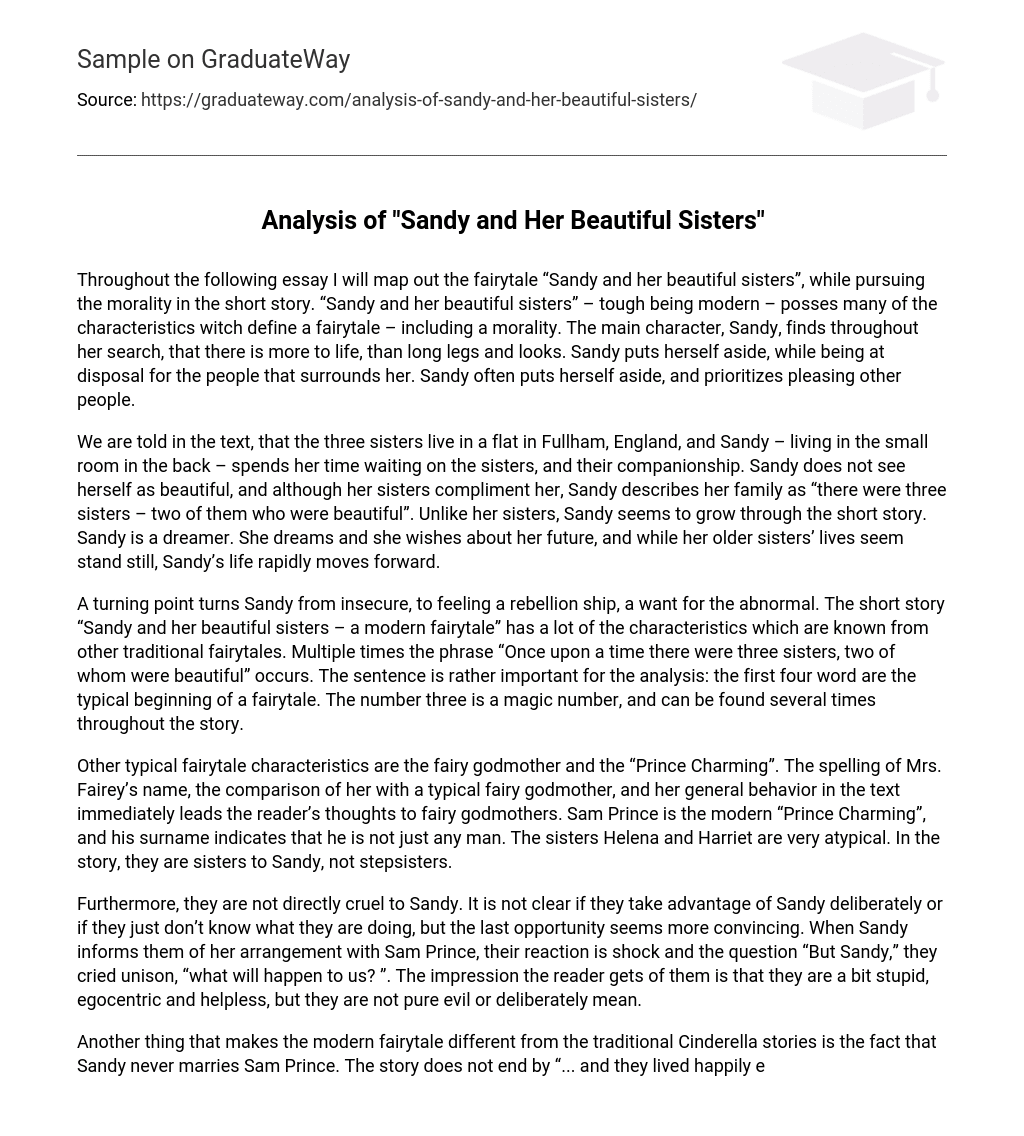Throughout this essay, I will analyze the fairytale “Sandy and her beautiful sisters” and explore its moral aspects. Despite its modern setting, the story possesses many traditional fairytale elements, including a moral message. The protagonist, Sandy, learns that there is more to life than physical beauty and attractiveness. She selflessly puts others before herself and frequently prioritizes the happiness of those around her.
According to the text, the three sisters reside in an apartment in Fullham, England. Sandy, who lives in a smaller room at the back, spends her time serving the sisters and enjoying their company. Sandy does not view herself as attractive, and although her sisters give her compliments, she perceives her family as “there were three sisters – two of them who were beautiful”. Unlike her siblings, Sandy experiences personal growth throughout the short story. She is a visionary, constantly dreaming and longing for her future. While her older sisters’ lives remain static, Sandy’s life progresses swiftly.
A turning point occurs in Sandy’s life that transforms her from being insecure to feeling a rebellious desire for something out of the ordinary. The short story titled “Sandy and her beautiful sisters – a modern fairytale” shares many characteristics with traditional fairytales. The phrase “Once upon a time there were three sisters, two of whom were beautiful” is repeated multiple times, and holds significant meaning in the analysis. The opening four words are typically used to start a fairytale, while the number three holds magical significance and is referenced numerous times in the story.
The text highlights typical fairytale elements, such as the presence of a fairy godmother and a “Prince Charming.” Mrs. Fairey’s name spelling, her resemblance to a typical fairy godmother, and her behavior in the text all evoke thoughts of fairy godmothers. Similarly, Sam Prince is portrayed as a contemporary “Prince Charming,” with his surname suggesting his exceptional nature. Contrary to the usual fairytale narrative, the sisters Helena and Harriet are not stepsisters, but rather siblings of Sandy in this story.
Furthermore, Sandy’s acquaintances are not actively mean to her. It remains uncertain whether they intentionally exploit Sandy or simply lack awareness, though the latter appears more plausible. When Sandy discloses her agreement with Sam Prince, their response is one of astonishment, exclaiming in unison, “But Sandy, what will become of us?” Their portrayal suggests a certain level of foolishness, self-centeredness, and vulnerability, yet they are not inherently wicked or intentionally cruel.
One aspect that sets the modern fairytale apart from traditional Cinderella stories is that Sandy and Sam Prince never get married. The story does not conclude with the classic phrase “and they lived happily ever after.” Instead, it is decided that Sam Prince will live with Sandy without being in a romantic relationship. Despite this, he remains incredibly supportive, while Sandy agrees to cook for him whenever he desires. The key distinction between the modern and traditional narratives is the emphasis on independence. Initially, the story seems to celebrate and incorporate the well-known morals found in traditional fairytales.
Personality, not appearance, determines success and luck in life. This story maintains a modern perspective while conveying timeless morals. However, not all of these morals align with modern society. For instance, one moral suggests that being a skilled cook is preferable to being an attractive yet incapable woman. This moral celebrates traditional gender roles but is not suitable for the 21st century.
The text communicates that beauty does not contribute to survival and highlights the concept of dependency on our loved ones. It emphasizes that we should not be subservient to others if it does not benefit us. The story is centered around the self and presents an ironic, humorous, and defining perspective on women such as Harriet and Helena. Another lesson from the story is to prioritize actions that serve our own interests. Throughout my essay, I have examined the short story as a contrast between contemporary fairytales and traditional ones.
After analyzing the text, I have identified various morals and supported my conclusions with examples. I particularly examined the contrast between modern and traditional elements as it highlights a significant point. While critically analyzing, I began to question the modernization of the fairytale. Sandy achieves the life she desired and hoped for, while retaining control and autonomy over her own life. This unconventional fairytale may indeed have its own unconventional happy ending, albeit without the presence of Prince Charming.





